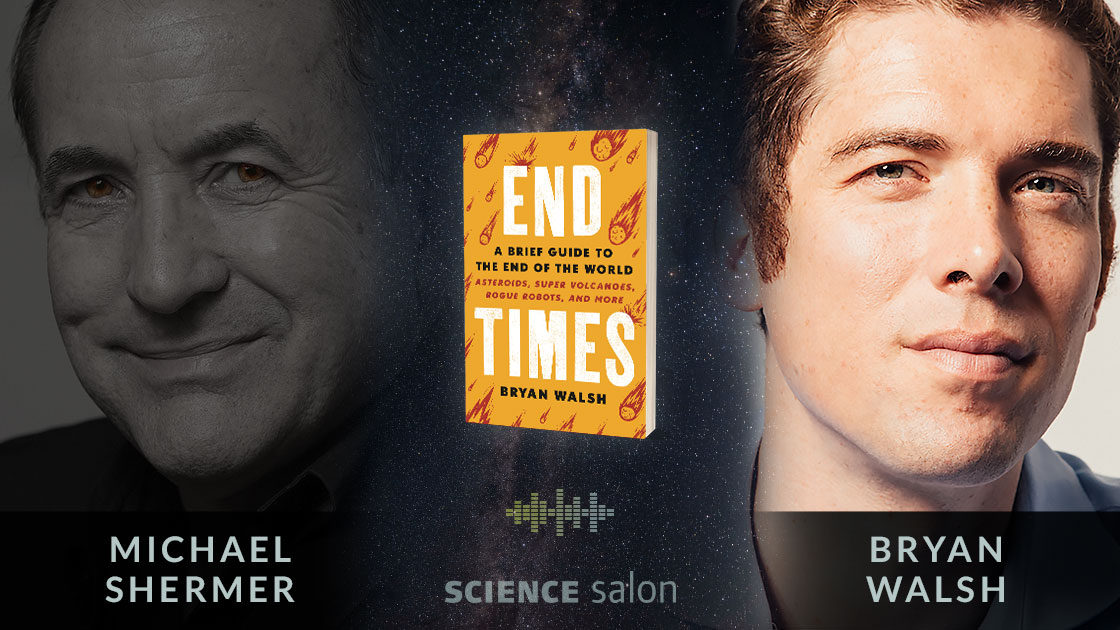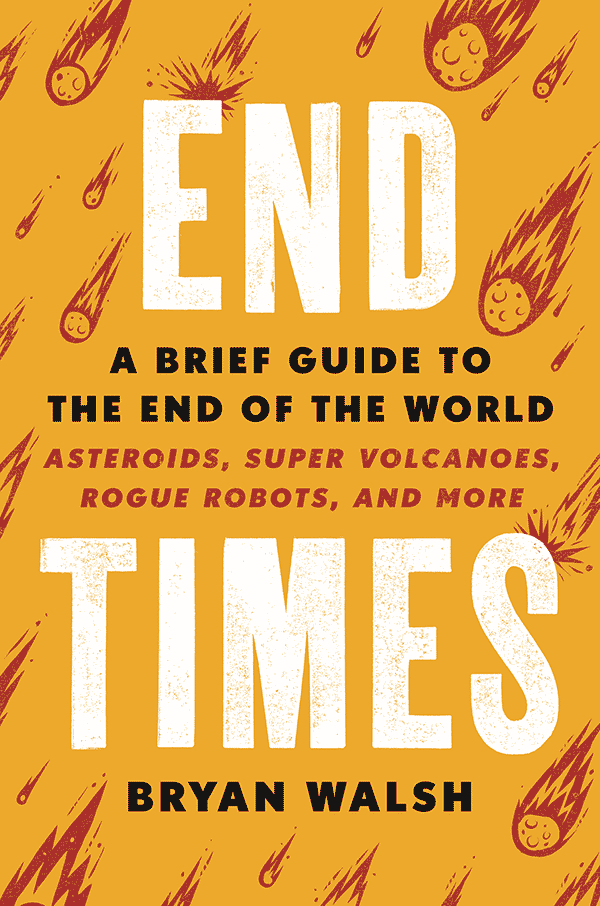End Times: A Brief Guide to the End of the World is a compelling work of skilled reportage that peels back the layers of complexity around the unthinkable—and inevitable—end of humankind. From asteroids and artificial intelligence to volcanic supereruption to nuclear war, 15-year veteran science reporter and TIME editor Bryan Walsh provides a stunning panoramic view of the most catastrophic threats to the human race. Walsh and Shermer discuss these existential threats to humanity and what to do about them:
- nuclear weapons
- killer diseases
- climate change
- artificial intelligence
- biotechnology
- asteroids and volcanos
- extraterrestrials, and
- preparing for doomsday: should we all be doomsday preppers?
A graduate of Princeton University, Bryan Walsh worked as a foreign correspondent, reporter, and editor for TIME for over 15 years. He founded the award-winning Ecocentric blog on TIME.com and has reported from more than 20 countries on science and environmental stories like SARS, global warming, and extinction. He lives in Brooklyn, NY, with his wife and son.
Listen to the podcast via Apple Podcasts, Spotify, Google Podcasts, Stitcher, iHeartRadio, and TuneIn.
You play a vital part in our commitment to promote science and reason. If you enjoy the Science Salon Podcast, please show your support by making a donation.
Addendum
In the discussion with Bryan Walsh about his new book End Times, in the section on nuclear weapons as an existential threat, the University of Washington Professor of Psychology David Barash, who is writing a book about the threat of nuclear weapons, points out two minor factual misstatements made about two Russian officials involved in nuclear close calls:
- The man responsible for the Soviet submarine not using its nuclear torpedo in 1962 during the Cuban Missile Crisis wasn’t the captain but a high ranking officer named Vasily Arihopv
- The “man who saved the world” in 1983 was Stanislav Petrov. Thanks to Dr. Barash for providing the following excerpts from his forthcoming book, Threats: From Animals to People, Society, and Countries (Oxford University Press, 2020).
1. Cuban Missile Crisis Close Call
Unknown to US authorities, the Soviets had already put at least 20 nuclear tipped missiles in Cuba, capable of reaching as far as Washington, D.C., each carrying a one-megaton nuclear warhead — equivalent to roughly 70 Hiroshima-size bombs. At the same time, a Soviet submarine submerged off the Cuban coast was being harassed by a US Navy surface flotilla, which was firing small depth charges, of the sort used in training exercises — not trying to destroy the submarine but rather in an effort to get it to surface. The submarine’s officers, however, believed they were under full attack; the US military was unaware that this sub was equipped with at least one nuclear-tipped torpedo. Unable to communicate with its military leadership in the Kremlin and having been given permission to use its nuclear weapon in “dire circumstances,” two out of the three officers with launch responsibility voted to fire their nuclear torpedo at the US fleet, believing that a war had already started. This would almost certainly have provoked a thermonuclear war. But the third officer, one Vasily Arkhipov, voted “No,” and so the Soviet submarine didn’t devastate a chunk of the US Navy, the US did not retaliate, and the world remained intact.
2. The 1983 “Man Who Saved the World” Close Call
An enormous naval exercise was conducted during April and May of 1983, which was a particularly crucial year, with three Pacific-based carrier battle groups simulating total war against the USSR. By design, US forces began probing the sensitivity (and restraint) of Soviet air defenses. Especially provocative was a mock bombing exercise in which US Navy aircraft actually flew over a Soviet military base on Zeleny Island, which the Soviets countered by flying over the Aleutians, leading Premier Andropov to order that any subsequent overflight of Soviet territory be shot down. At the time, the US was about to deploy its Pershing II missiles in Europe. And then, sure enough, in September of that same fateful year, Soviet radar reported what they believed was a US spy plane in Soviet airspace over Siberia. An Su-15 interceptor was ordered to shoot it down. The intruder was no spy plane, but Korean Airlines flight 007, a commercial airliner bound for Seoul that had gone off-course, and whose communications with the scrambled Soviet jet were garbled. There were 269 civilian passengers, all of whom perished, including 62 Americans (one being a sitting congressman who was chairman of the bellicosely anti-communist John Birch Society) and 22 children under the age of 12.
The West was outraged. President Reagan denounced Soviet “barbarity,” and then things got even more dangerous. On September, 26, three weeks after the shooting down of KAL 007, a newly installed Soviet early warning satellite system sent an alert that a US ICBM had been launched and was heading toward the USSR, followed by a possible four more. The mid-ranking duty officer in the early warning command system, Lt. Col. Stanislav Petrov, decided — on his own and counter to explicit military protocol — not to report this incident, which he judged to be a false alarm. And so it was. (Part of his reasoning was that a real first strike would have involved hundreds of missiles, not just a hand-full.) Had he informed his superior officers, General Secretary Andropov et al would have had just minutes to decide whether or not to “retaliate,” and given the tense state of US-Soviet relations at that time, the outcome could easily have been disastrous. Petrov was nonetheless officially reprimanded for his non-action; shortly thereafter he left the Soviet military and, in May, he died in relative poverty. Interviewed for the film, The Man Who Saved the World, Petrov said this about his role in the incident, “I was simply doing my job … that’s all. My late wife for 10 years knew nothing about it. ‘So what did you do?’ she asked me. ‘Nothing. I did nothing.’” Petrov’s “nothing” could well have saved the world.
This episode was released on August 27, 2019.












